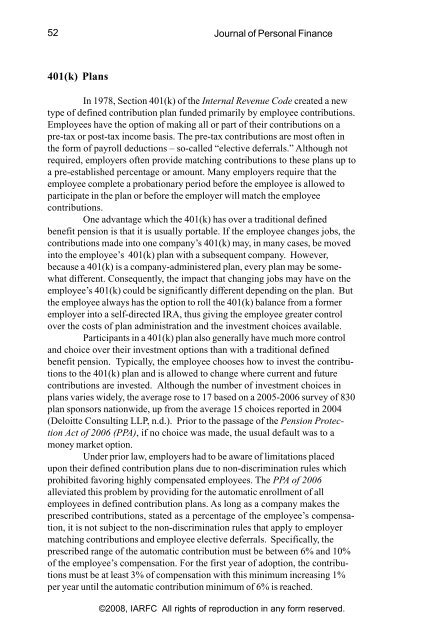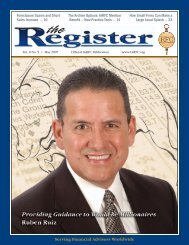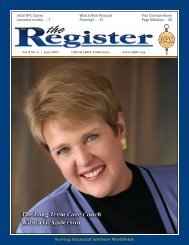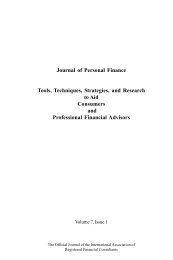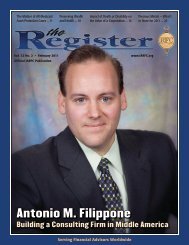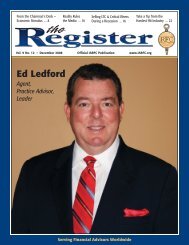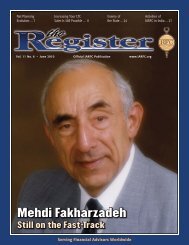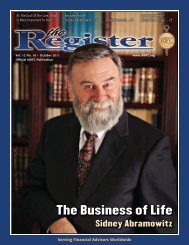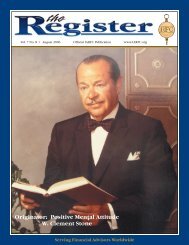3433-vol. 6 issue 2-3.pmd - iarfc
3433-vol. 6 issue 2-3.pmd - iarfc
3433-vol. 6 issue 2-3.pmd - iarfc
Create successful ePaper yourself
Turn your PDF publications into a flip-book with our unique Google optimized e-Paper software.
52<br />
Journal of Personal Finance<br />
401(k) Plans<br />
In 1978, Section 401(k) of the Internal Revenue Code created a new<br />
type of defined contribution plan funded primarily by employee contributions.<br />
Employees have the option of making all or part of their contributions on a<br />
pre-tax or post-tax income basis. The pre-tax contributions are most often in<br />
the form of payroll deductions – so-called “elective deferrals.” Although not<br />
required, employers often provide matching contributions to these plans up to<br />
a pre-established percentage or amount. Many employers require that the<br />
employee complete a probationary period before the employee is allowed to<br />
participate in the plan or before the employer will match the employee<br />
contributions.<br />
One advantage which the 401(k) has over a traditional defined<br />
benefit pension is that it is usually portable. If the employee changes jobs, the<br />
contributions made into one company’s 401(k) may, in many cases, be moved<br />
into the employee’s 401(k) plan with a subsequent company. However,<br />
because a 401(k) is a company-administered plan, every plan may be somewhat<br />
different. Consequently, the impact that changing jobs may have on the<br />
employee’s 401(k) could be significantly different depending on the plan. But<br />
the employee always has the option to roll the 401(k) balance from a former<br />
employer into a self-directed IRA, thus giving the employee greater control<br />
over the costs of plan administration and the investment choices available.<br />
Participants in a 401(k) plan also generally have much more control<br />
and choice over their investment options than with a traditional defined<br />
benefit pension. Typically, the employee chooses how to invest the contributions<br />
to the 401(k) plan and is allowed to change where current and future<br />
contributions are invested. Although the number of investment choices in<br />
plans varies widely, the average rose to 17 based on a 2005-2006 survey of 830<br />
plan sponsors nationwide, up from the average 15 choices reported in 2004<br />
(Deloitte Consulting LLP, n.d.). Prior to the passage of the Pension Protection<br />
Act of 2006 (PPA), if no choice was made, the usual default was to a<br />
money market option.<br />
Under prior law, employers had to be aware of limitations placed<br />
upon their defined contribution plans due to non-discrimination rules which<br />
prohibited favoring highly compensated employees. The PPA of 2006<br />
alleviated this problem by providing for the automatic enrollment of all<br />
employees in defined contribution plans. As long as a company makes the<br />
prescribed contributions, stated as a percentage of the employee’s compensation,<br />
it is not subject to the non-discrimination rules that apply to employer<br />
matching contributions and employee elective deferrals. Specifically, the<br />
prescribed range of the automatic contribution must be between 6% and 10%<br />
of the employee’s compensation. For the first year of adoption, the contributions<br />
must be at least 3% of compensation with this minimum increasing 1%<br />
per year until the automatic contribution minimum of 6% is reached.<br />
©2008, IARFC All rights of reproduction in any form reserved.


